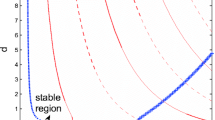Abstract
We develop a method to estimate the expected time of survival of a predator population as a function of the size of the habitat island on which it lives and the dynamic parameters of the population and its prey. The model may be thought of either as a patch occupancy model for a structured population or as a model of metapopulation type. The method is applied to a keystone predator species, the neotropical army ant Eciton burchelli. Predictions are made as to how many of the islands and habitat islands in and around Gatun Lake in the Panama Canal, most of which were formed when the canal was dug, can be expected to support such a population today, and these are compared with data.
Similar content being viewed by others
References
Boswell, G. P., N. F. Britton and N. R. Franks (1998). Habitat fragmentation, percolation theory and the conservation of a keystone species. Proc. R. Soc. B265, 1921–1925.
Britton, N. F., L. W. Partridge and N. R. Franks (1996). A mathematical model for the population dynamics of army ants. Bull. Math. Biol. 58, 471–492.
Caswell, H. and R. J. Etter (1993). Ecological interactions in patchy environments: from patch-occupancy models to cellular automata, in Patch dynamics, S. A. Levin, T. M. Powell and J. H. Steele (Eds), Lecture Notes in Biomathematics 96, Berlin: Springer Verlag, pp. 93–109.
Czaran, T. and S. Bartha (1992). Spatiotemporal dynamic models of plant populations and communities. Trends Ecol. Evol. 7, 38–42.
DeAngelis, D. L. and L. J. Gross (1992). Individual-based Models and Approaches in Ecology, New York: Chapman and Hall.
Durrett, R. (1992). Stochastic models of growth and competition, in Patch dynamics, S. A. Levin, T. Powell and J. Steele (Eds) New York: Springer Verlag. pp. 176–183.
Durrett, R. and S. A. Levin (1994). Stochastic spatial models: a user’s guide to ecological applications. Phil. Trans. R. Soc. Lond. B343, 329–350.
Ellis, R. S. (1985). Entropy, Large Deviations and Statistical Mechanics, New York: Springer Verlag.
Feller, W. (1968). An Introduction to Probability Theory and its Applications, Vol. I, New York: Wiley, 3rd Edn.
Fisch, R., J. Gravner and D. Griffeath (1991). Threshold range scaling of excitable cellular automata. Statist. Comp. 1, 23–29.
Franks, N. R. (1982a). Ecology and population regulation in the army ant Eciton burchelli, in The Ecology of a Tropical Forest: Seasonal Rhythms and Long-term Changes, E. G. Leigh, A. S. Rand and D. M. Windsor (Eds). Washington, D.C.: Smithsonian Institution Press, pp. 389–395.
Franks, N. R. (1982b). A new method for censusing animal populations: the number of Eciton burchelli army ant colonies on Barro Colorado Island, Panama. Oecologia, Berlin 52, 266–268.
Franks, N. R. (1982c). Social insects in the aftermath of swarm raids of the army ant Eciton burchelli, in Biology of Social Insects, Proceedings of the 9th International Congress of the International Union for the Study of Social Insects, Boulder, Colorado, M. D. Breed, C. D. Michener and H. E. Evans (Eds). Boulder, CO; Westview Press, pp. 275–279.
Franks, N. R. (1985). Reproduction, foraging efficiency and worker polymorphism in army ants, in Experimental Behavioral Ecology, No. 31 in Fortschritte der Zoologie, M. Lindauer and B. Hölldobler (Eds). New York: G. Fischer, pp. 91–107.
Franks, N. R. (1989). Army ants: a collective intelligence. Am. Sci. 77, 139–145.
Franks, N. R. and W. H. Bossert (1983). The influence of swarm raiding army ants on the patchiness and diversity of a tropical leaf litter ant community, in The Tropical Rain Forest: Ecology and Management, E. L. Sutton, A. C. Chadwick and T. C. Whitmore (Eds). Oxford: Blackwell, pp. 151–163.
Franks, N. R. and C. R. Fletcher (1983). Spatial patterns in army ant foraging and migration: Eciton burchelli on Barro Colorado Island, Panama. Behav. Ecol. Sociobiol. 12, 261–270.
Franks, N. R., N. Gomez, S. Goss and J. L. Deneubourg (1991). The blind leading the blind in army ant raid patterns: testing a model of self-organization. J. Insect Behavior 4, 583–607.
Franks, N. R. and B. Hölldobler (1987). Sexual competition during colony reproduction in army ants. Biol. J. Linnean Soc. 30, 229–243.
Hassell, M. P., H. N. Comins and R. M. May (1991). Spatial structure and chaos in insect population dynamics. Nature 353, 255–258.
Karlin, S. and H. M. Taylor (1981). A Second Course in Stochastic Processes, New York: Academic Press.
Levins, R. (1969). Some demographic and genetic consequences of environmental heterogeneity for biological control. Bull. Ent. Soc. Am. 15, 237–240.
MacArthur, R. H. and E. O. Wilson (1967). The Theory of Island Biogeography, Princeton, NJ: Princeton University Press.
Mangel, M. and C. Tier (1994). Four facts every conservation biologist should know about persistence. Ecology 75, 607–614.
Nisbet, R. M. and W. S. C. Gurney (1982). Modelling Fluctuating Populations, Chichester: Wiley.
Partridge, L. W. (1994). Facets of the ecology, behaviour and evolution of ants, PhD thesis, University of Bath.
Partridge, L. W., N. F. Britton and N. R. Franks (1996). Army ant population dynamics: the effects of habitat quality and reserve size on population size and time to extinction. Proc. R. Soc. B263, 735–741.
Renshaw, E. (1993). Modelling Biological Populations in Space and Time, Cambridge: Cambridge University Press.
Roughgarden, J. (1979). Theoretical Population Genetics and Evolutionary Ecology, Endlewood Cliffs, NJ: Prentice-Hall.
Willis, E. O. and Y. Oniki (1978). Birds and army ants. Ann. Rev. Ecol. Syst. 9, 243–263.
Author information
Authors and Affiliations
Rights and permissions
About this article
Cite this article
Britton, N.F., Partridge, L.W. & Franks, N.R. A model of survival times for predator populations: The case of the army ants. Bull. Math. Biol. 61, 469–482 (1999). https://doi.org/10.1006/bulm.1998.0091
Received:
Accepted:
Issue Date:
DOI: https://doi.org/10.1006/bulm.1998.0091




